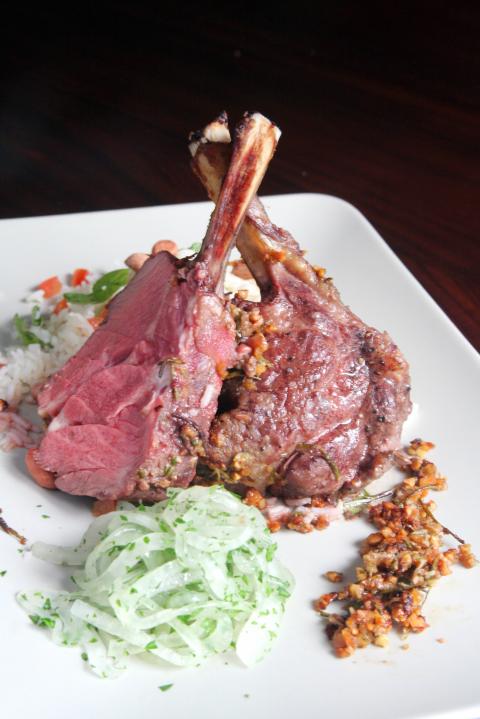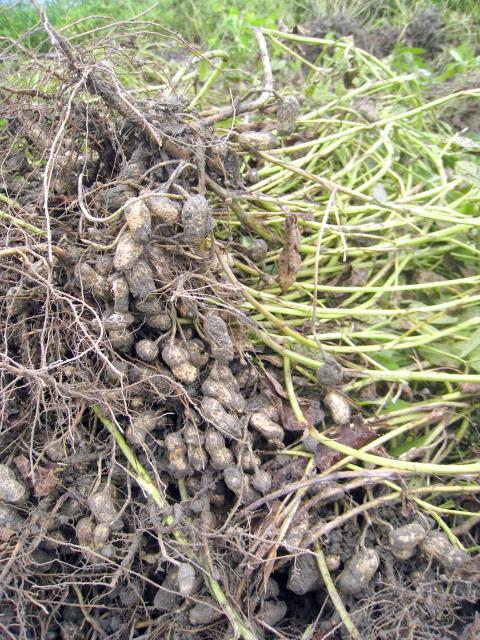Growing up in Australia, peanuts meant little packets of salted nuts that helped people knock back more gassy lager than they actually wanted. They were a fast food, a quick snack, the satisfaction of eating them coming more from the heavy doses of salt in which they were seasoned rather than the nuts themselves. I had no time for peanuts, and still less for peanut oil, which even now I associate with cheap, rancid tasting stir-fries, even though many Asian food stalls these days have moved on to even cheaper, highly-processed blended vegetable oils.
Having moved to Hualien, my relationship to peanuts underwent a major change. White rice and peanuts, with a dash of soy sauce, is one of my favorite comfort foods when I don’t feel like cooking. And the reason is nothing more or less than access to really good, roasted peanuts. My provider of choice is Goodeatss Peanuts (美好花生), a small establishment in Fenglin Township (鳳林) in Hualien County, which maintains a tradition of hand-selecting and hand-frying its peanuts. I’ve written about them before (Taipei Times, Aug. 15, 2013, page 12), and the appeal of their product has never waned. There are also other quality producers working out of other peanut growing areas such as Chiayi County and Tainan. My point here is that Taiwan has some fine peanut brands, but the most easily available remain generic snack peanuts, often oily and heavily salted, which do a great injustice to the abundant flavor of this humble crop.
Growing and processing peanuts is a labor intensive business. My neighbor, an old farmer in his 80s, has been growing peanuts for decades, and with the arrival of winter, there are always the long days of digging up the nuts, selecting them and steaming them over a wood fire. Fall is announced by a bucket of these steamed peanuts that are a great accompaniment to a meal or picked over while watching TV. Watching this laborious work, as he squats over the short plants and grubbing out the nuts from the earth, only adds to the appreciation of the commitment of artisanal producers.

Photo: Ian Bartholomew
Perhaps two of the most famous Chinese dishes that make use of the peanut are kungpao Chicken (宮保雞丁), in which roasted peanuts provide a delightful crunch to fried spicy chicken, and pig’s trotter with peanuts (花生豬腳), which is the post-natal food of choice for believers in Chinese medicine, and which also is supposed to be a sovereign remedy for all sorts of physical aches and pains. And in Southeast Asia, few travelers will have missed out on the spicy peanut sauce that is the accompaniment for beef and mutton satay and other skewer roast meat dishes from Indonesia to Thailand. And for a more Western take, there is always handmade peanut butter, which, in its most healthy iteration, only really needs peanuts and pure peanut oil, with the optional addition of salt, sugar or honey. It should be noted that pure peanut oil is a very different beast from the big tubs of processes peanut oil available at every supermarket. It is a product that can be used in the same way as a fine walnut oil, flavoring a salad or a piece of meat, rather than simply valued for its ability to withstand high temperatures (a quality that has made it a popular oil for stir-fry and deep-fry cooking).
It doesn’t take much to realize that peanuts have a huge international presence, but like so many cultivars that have become major commercial crops, the flavor and nutritional gulf between mass-market and artisanal products is so wide that from a foodie’s point of view, they are simply two completely different products.
The nutritional profile of the peanut is pretty appealing for anyone looking for a great source of energy, and according to whfoods.org’s The World’s Healthiest Foods, a high monounsaturated diet that emphasizes peanuts and peanut butter decreased cardiovascular disease risk by an estimated 21 percent compared to the average American diet. You can’t help but like numbers like that.

Photo: Ian Bartholomew
Peanuts are also said to rival fruits as a source of antioxidants, and are a rich source of oleic acid, the healthful fat found in olive oil. They are also said to protect against Alzheimer’s and age-related cognitive decline and, most surprising, a study published in the journal Obesity shows that peanuts are effective in controlling weight gain. Apart from being good for the body, they are also a sustainable crop. Like most other legumes (it is an oddity that the peanut is in fact not a nut at all, but a legume, more closely related to peas than almonds), peanuts harbor symbiotic nitrogen-fixing bacteria, and this means they require less nitrogen-containing fertilizer and help improve soil fertility.
Sadly, peanuts are one of those foods that seem to have a close association with allergic reactions, and while I am profuse in my praise of this splendid legume, care should be taken when offering such dishes to people who may have peanut allergies.
Peanut, rosemary and honey crusted rack of lamb
Recipe
(serves 4)
Ingredients
500g rack of lamb (approx. 8 ribs)
10g rosemary leaves, fresh
20g dry-roasted peanuts, chopped
2 cloves of garlic, chopped
2 stems spring onions
zest of half a lemon
1/2 tsp chili flakes
1 tbsp Dijon mustard
1 tsp pure peanut oil (or extra virgin olive oil)
1 tbsp honey
Salt and pepper to season
Directions
1. Ensure the meat is at room temperature (remove from fridge about an hour before cooking). Season generously with salt and pepper.
2. Preheat oven to 180c.
3. Chop the rosemary, garlic, spring onions and peanuts. Add mustard, oil and honey to make a thick paste.
4. Apply the paste to the ribs, with a thick layer on the outer surface. Steeple the ribs (four ribs each side) and roast in the middle of the oven for 30min to 40min depending on degree of doneness (internal temperature should be 54c for rare, which is very red and deliciously moist, or up to 62c for medium). Personally I do not think that lamb should be cooked beyond this stage, but there are those who will cook it up to 73c or more to ensure the juices run clear.
5. Serve with herbed basmati rice and onion and parsley salad.
Herbed Basmati rice and onion salad
Ingredients
For Rice
1 cup Basmati rice, cooked
Olive oil
4 spring onions, chopped into sections
2 cloves garlic, sliced
2 small green chilies, chopped
1 tomato, seeded and chopped
8-10 basil leaves, torn
Sea salt
For Salad
1 brown onion, thinly sliced
Sea salt
Small bunch parsley, finely chopped
Olive oil
1. Heat a pan with olive oil and add spring onions and garlic. Cook over medium heat until soft and just beginning to color. Set aside.
2. Put the warm rice into a bowl and add remaining ingredients. Stir well.
3. Mix the thinly sliced onion and salt. Leave for half an hour until the onion releases water. Squeeze to drain off as much water as possible. Stir in parsley and add a little olive oil.

On April 26, The Lancet published a letter from two doctors at Taichung-based China Medical University Hospital (CMUH) warning that “Taiwan’s Health Care System is on the Brink of Collapse.” The authors said that “Years of policy inaction and mismanagement of resources have led to the National Health Insurance system operating under unsustainable conditions.” The pushback was immediate. Errors in the paper were quickly identified and publicized, to discredit the authors (the hospital apologized). CNA reported that CMUH said the letter described Taiwan in 2021 as having 62 nurses per 10,000 people, when the correct number was 78 nurses per 10,000

As we live longer, our risk of cognitive impairment is increasing. How can we delay the onset of symptoms? Do we have to give up every indulgence or can small changes make a difference? We asked neurologists for tips on how to keep our brains healthy for life. TAKE CARE OF YOUR HEALTH “All of the sensible things that apply to bodily health apply to brain health,” says Suzanne O’Sullivan, a consultant in neurology at the National Hospital for Neurology and Neurosurgery in London, and the author of The Age of Diagnosis. “When you’re 20, you can get away with absolute

May 5 to May 11 What started out as friction between Taiwanese students at Taichung First High School and a Japanese head cook escalated dramatically over the first two weeks of May 1927. It began on April 30 when the cook’s wife knew that lotus starch used in that night’s dinner had rat feces in it, but failed to inform staff until the meal was already prepared. The students believed that her silence was intentional, and filed a complaint. The school’s Japanese administrators sided with the cook’s family, dismissing the students as troublemakers and clamping down on their freedoms — with

As Donald Trump’s executive order in March led to the shuttering of Voice of America (VOA) — the global broadcaster whose roots date back to the fight against Nazi propaganda — he quickly attracted support from figures not used to aligning themselves with any US administration. Trump had ordered the US Agency for Global Media, the federal agency that funds VOA and other groups promoting independent journalism overseas, to be “eliminated to the maximum extent consistent with applicable law.” The decision suddenly halted programming in 49 languages to more than 425 million people. In Moscow, Margarita Simonyan, the hardline editor-in-chief of the